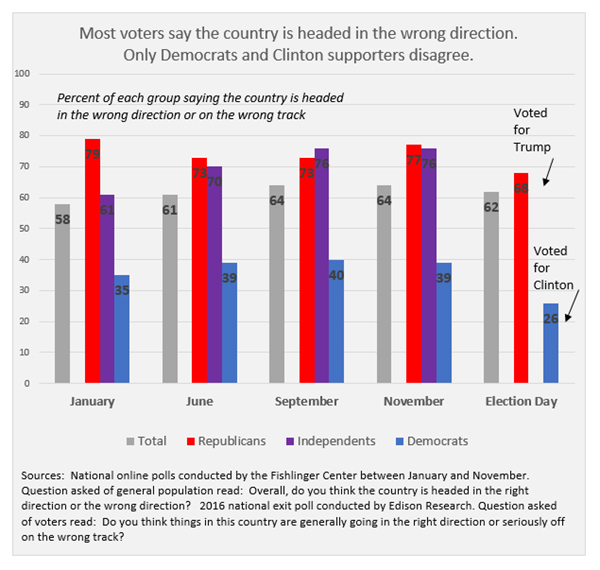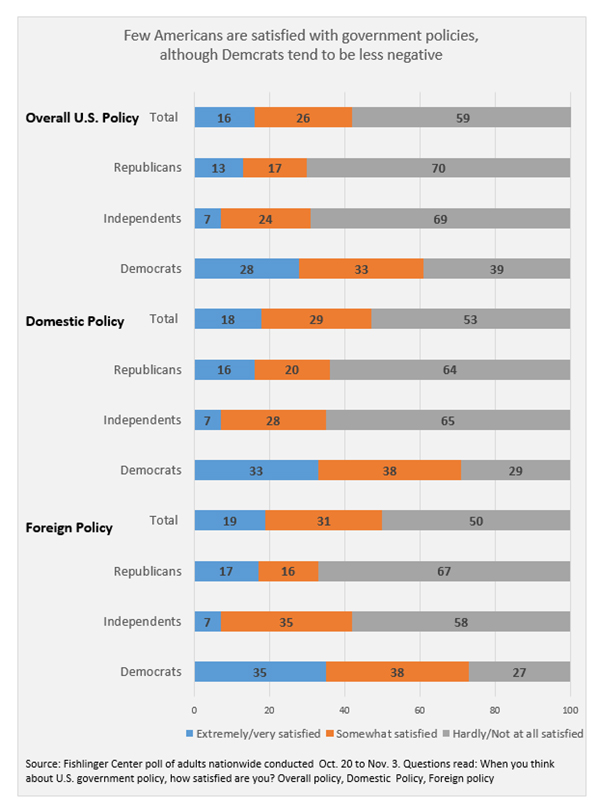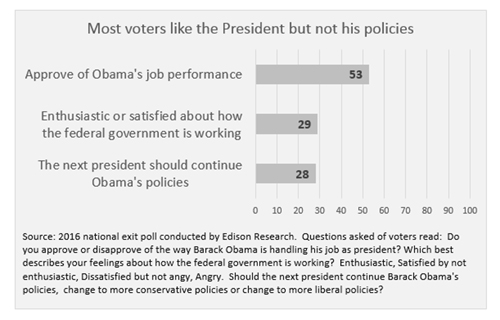Presidential Election 2016:
A Retrospective
12/6/2016
Few pollsters or pundits expected Donald Trump’s Electoral College win last month. A Hillary Clinton victory was predicted by forecasters and reinforced in the media. In an election year rich in data with state-of-the-art methods of analyzing it, the question is: What happened? The pre-election errors of the polls and media have already been the focus of several academic and professional polling symposia, and will undoubtedly be the main topic for months to come.
The Fishlinger Center’s pre-election polls, like most other national polls, showed Mrs. Clinton ahead of Mr. Trump. National pre-election polls estimate the national popular vote, not the Electoral College, and Mrs. Clinton won the popular vote by more than 2.5 million votes. The final results of many national polls which had Mrs. Clinton ahead of Mr. Trump by a small margin, were generally within the poll’s margin of sampling error.
However, poll analysis that suggested a close contest for president was rare, and most forecasters gave Mrs. Clinton a very high probability of winning. The pervasive assumption was that Mrs. Clinton was sure to prevail on Election Day – with both the popular vote and the Electoral College.
A re-examination of the Fishlinger Center’s pre-election surveys suggest there may have been hints of the softness of Mrs. Clinton’s support as dissatisfaction with the current state of affairs in Washington fueled Mr. Trump’s supporters.
Throughout the election year, about 6 in 10 Americans said the country was headed in the wrong direction, including between 7o and 80 percent of Republicans, and 60 to 70 percent of independents. In contrast, about 6 in 10 Democrats said the country was headed in the right direction. Only the majority Democrats and Clinton supporters felt the country was headed in the right direction. The majority of Republicans and independents did not.
The national exit poll conducted for the television networks and The Associates Press by Edison Research got similar results: 62 percent of voters said the country was on the wrong track, and 68 percent of them voted for Mr. Trump.

The Fishlinger polls also found that only the majority of Democrats were at least somewhat satisfied with the government in general and with both domestic and foreign policies while the majority of Republicans and independents were not very or not at all pleased with the government.

Similarly, in the exit poll, 7 in 10 voters had a negative view of how the federal government is running, and more than half of them voted for Mr. Trump.
While most Americans are unhappy with the government’s policies, it does not appear that President Obama is getting the blame. More than half, 53 percent, of the voters in the exit poll, approved of Mr. Obama’s job performance. However, the positive feelings toward the Obama administration seems to be more for Mr. Obama himself, rather than his policies. Only 28 percent of voters said the next president should continue Mr. Obama’s policies. Nearly half, 47 percent, said the next president should change to more conservative policies and more than 8 in 10 of those voters backed Mr. Trump.

Presidential job approval has been a strong indicator of whether or not an incumbent is elected to a second term. But history is mixed regarding the effect of an incumbent’s popularity on voters’ selection of the successor. At the end of his eighth year in office, Ronald Reagan earned approval ratings similar to Mr. Obama. And the Republican nominee, George H.W. Bush, was elected in 1988. However, two presidents with even higher approval ratings – Dwight D. Eisenhower and Bill Clinton – were not succeeded by their party’s nominee. Both Al Gore in 2000 and Richard M. Nixon in 1960 were narrowly defeated. In fact, like Mrs. Clinton, Mr. Gore won the popular vote, but ended up losing the Electoral College.
Survey Methodology
The Fishlinger Center conducted online national surveys focusing on political issues in the United States ahead of the 2016 Presidential election. The fieldwork for the polls is conducted using a blended national panel from Survey Sampling Inc.

In addition to credibility interval, the polls are subject to other potential sources of error including, but not limited to coverage and measurement error. Data were rim weighted to match the national population on age, sex, Hispanic origin and race. Question wording and topline results are available at fishlingercenter@mountsaintvincent.edu.
About the Fishlinger Center for Public Policy
The Fishlinger Center for Public Policy Research opened in February 2015 at the College of Mount Saint Vincent. The Center, a member of the American Association for Public Opinion Research (AAPOR), conducts deep and broad studies of public opinion on key public policy concerns through independent and objective research conducted by students, faculty, and other members of the academic community.
By providing a forum for discourse that can stimulate intelligent dialog about issues that deeply affect all Americans, the Center illustrates and enhances the relationship between the work of the College and the common good.
About the College of Mount Saint Vincent
Founded in 1847 by the Sisters of Charity, the College of Mount Saint Vincent offers nationally recognized liberal arts education and a select array of professional fields of study on a landmark campus overlooking the Hudson River. Committed to the education of the whole person, and enriched by the unparalleled cultural, educational and career opportunities of New York City, the College equips students with the knowledge, skills and experiences necessary for lives of achievement, professional accomplishment and leadership in the 21st century.
